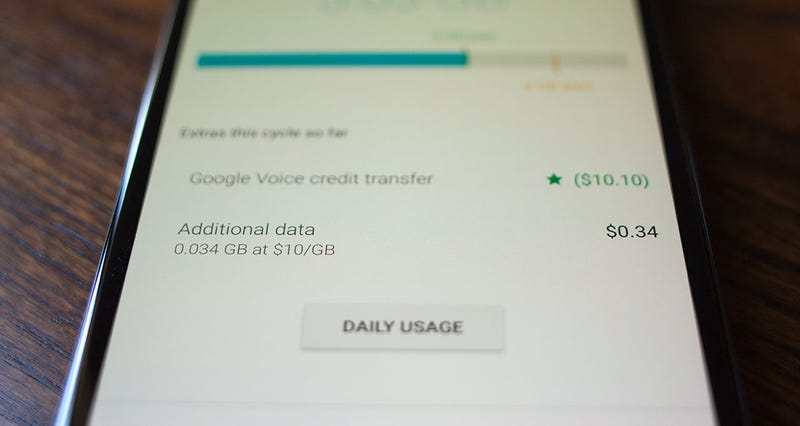Why I'll Probably Ditch My Carrier For Google's Project Fi
One month ago, we tried Google’s experimental cell phone service. It was a disaster. But I guess the second time’s a charm. After spending two weeks with Project Fi in the San Francisco Bay Area, I’m just about ready to ditch my old carrier.
What’s Project Fi?
To recap, Project Fi is a new way to use a cellphone. It works like this:
1.) You buy a Nexus 6. Right now, they cost $350 completely unlocked.
2.) You buy a special Project Fi SIM card from Google. (They’re invite-only at the moment.) It arrives in the mail.
3.) You pop it into your new phone, and download the Fi app. Setup takes about five minutes.
4.) You prepay $20 for unlimited calls and texts, and $10 per GB of data—no matter how much or little you use. No overage fees. Any data you don’t use gets credited back to your account at $10/GB—right down to the dime.
5.) If anything goes wrong (other than an utter lack of service) press a button in the Fi app. A Google tech support person will call you.
6, AKA The Big One) The key difference between Fi and your regular carrier, is that your phone will automatically switch between multiple different cellular networks and wifi to stay constantly connected—even if you go abroad. In the US, the service is a combination of T-Mobile and Sprint. Abroad, Google says it’ll work in over 120 different countries. International calls cost $0.20 a minute, but you can keep using your data at $10/GB as if you never left home.
I thought you said it was a disaster?
It was—for Darren, who had some serious issues. But my experience was pretty incredible, with a few important caveats.
So what are the problems with Project Fi?
Okay, so you know how Google advertises Project Fi as a service that’ll always connect you to the fastest network available? They phrased it like this:
We developed new technology that gives you better coverage by intelligently connecting you to the fastest available network at your location whether it’s Wi-Fi or one of our two partner LTE networks.
That’s just not remotely true in my experience.
I watched my phone like a hawk while driving around the SF Bay Area, riding Caltrain between San Francisco and San Jose, and during a 45 minute walk through the heart of downtown SF, and it was patently obvious that Fi isn’t intelligent enough to compare networks on the fly and switch to the one that’s fastest.
Several times I found that Fi had connected me to a wifi network that was substantially slower than Sprint or T-Mobile LTE at the same exact location. (I tested.) It’s cool that it was saving me money, but still.
And I also never, ever saw Fi switch from Sprint to T-Mobile or vice versa when I was dealing with 3G or HSPA connectivity. If the signal went out entirely, sure, it’d try to switch. (Or if I hit the Airplane Mode toggle to simulate the same effect.) But not on its own.
Oh, and you can’t make a phone call and use cellular data at the same time.
Oh, and occasionally incoming calls would go straight to voicemail without ringing. That’s kinda bad.
Oh, and even though Fi’s coverage map shows solid, unbroken 4G LTE coverage in every single area I visited (so do T-Mobile and Sprint’s own maps, by the way) I definitely saw a decent amount of slower HSPA and even some EV-DO while driving and on Caltrain.
Oh, and sometimes when I’d test my Fi phone on T-Mobile and an actual T-Mobile phone in the same exact location, the Fi phone would get responses back from servers and websites a good bit slower. It’d feel a hair less responsive.
So if all of that sucked, why are you switching?
I don’t know about you, but I don’t make a lot of calls anymore, and my data usage varies dramatically from month to month. (Sometimes, I spend a lot of time on wifi.) I love the idea of having a cell phone bill that starts at just $30, and can stretch to whatever I need.
And if I’m being honest, the vast majority of the time I spent using Fi, I had an pretty solid connection. I measured Speedtest.net results on par with my Verizon phone most places I went. (Sometimes that meant crazy speeds of 42Mbps up and 20Mbps down, sometimes more like 12Mbps up and 3Mbps down, and yes, sometimes the needle would barely register.)
The only place where Fi was consistently worse was inside my own home—where I’ve got wifi anyhow.
The fact is, I’m tired of the bullshit and bloatware and locked-down Android smartphones that come with cellular carriers, and now that they aren’t subsidizing my next smartphone purchase, I’d already made up my mind to pay full price for an unlocked handset either way.
If we see some new Nexus phones on September 29th and if they’re suitably awesome and if they support Project Fi, I’m pretty sure Google will be my next cellular carrier. I mean, I guess I could switch sooner—but that Nexus 6 is just too damn big.
Contact the author at @starfire2258.
The following replies are approved. To see additional replies that are pending approval, click Show Pending. Warning: These may contain graphic material.





-Standard Settings (like what they have now)
-Fastest Internet
-Strongest Signal
-Most Wi-Fi (cheapest?)